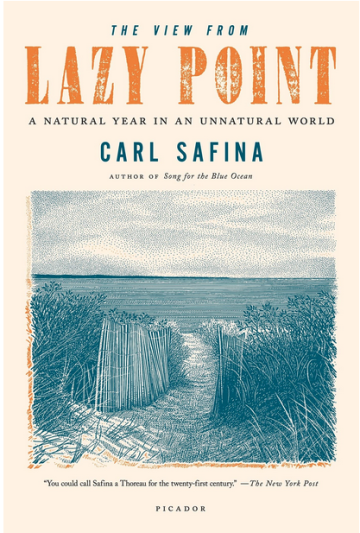The View From Lazy Point - Interview with Carl Safina
Perhaps it's ironic. The morning I'm to drive out to Long Island and meet with Carl Safina, one of the leading voices sounding the alarm on global warming, I'm stranded by snow. An inspired storm the night before drops another few feet of frosting on the Metropolitan area, burying my car up to its windows and making my little City side-street nearly impassible. I don't give up easily, but I'm no John Henry with a shovel, and I'm resigned to canceling the interview. I'm disappointed as I dial, frustrated I won't be able to sit down with the man whose new book “The View From Lazy Point” (Henry Holt & Company) has been cited by critics as an “immortal work of popular natural history” and the “21st Century's Walden Pond.” I'm also embarrassed – how to tell a person who has spent considerable time roughing it in places polar, exploring glaciers and traversing ice sheets, that I can't manage to dig out my Ford Focus.
But my fears are misguided. Carl is gracious and understanding, admitting the weather has cornered him as well. And so we talk on the phone. My focus during the interview with Carl is on writing, not necessarily the environment. That's not to say that “The View From Lazy Point” didn't grab my conservationist soul and shake it around a bit, but I'm selfish, eager to learn how he created such a fluid, yet contrasting book, how he was able to balance hard statistic with surreal vision, sober thought with drifting dream, historical reference with prophetic imagination. Moreover, how did he corral into cogency a year (2009) crammed with divergent activities and far-ranging experiences nascent to his profession and his calling as a naturalist – from watching horseshoe crabs mate by moonlight in a nearby bay to walking the melting, mushy permafrost of Southeast Alaska with an Inupiat Eskimo elder whose town (and his people's age-old way of life) is disappearing into rising-sea oblivion.
The answer, simply, is hard work. Carl tells me he routinely put in 12 to 14 hour days writing “The View From Lazy Point,” papering his office with notes and passages from the manuscript. “I created a sort of map on the walls, breaking down the different scenes and subjects I wanted to include in the book,” he says. “I moved the items around as if they were pieces in a puzzle, trying to find the right fit that would make sense for readers. It was a difficult process, a real struggle. In fact, the running joke around my house at that time was my nearly daily announcement ‘that I finally got the structure of the book right.' But eventually it came together.”
I agree. The “View From Lazy Point” moves in smooth lockstep with the calendar, month-to-month, season-to-season, from one winter to the next, a circle of life seen through the eyes of someone who values it. Carl uses the natural world as a poet might use form, only instead of rhyme scheme or syllable count, the boundaries for his prose are cold snaps and drenching rains, migrating terns and microscopic coral, high tides and suffocating seaweed. And like any good poet, he knows how to keep a beat. When I comment that I found his writing to have a musical quality, he tells me he once was a drummer, touring in a band. The connection makes sense: the book pulses with percussionist power – finger-snapping sentences, symbol-clang segues, long passages more riff than rant.
Our conversation moves to motivation. “I was born in Brooklyn,” Carl begins, when I ask about his early influences, "and when I was young my father would take me fishing to Sheepshead Bay, which was nearby and where you could go out for the day on party boats. But it was only when I was nine years old and my family spent several weeks in the Catskills that I was really exposed to nature, to animals and birds and forests, something I'd only before seen or read about in books. Not long after, we moved to a more rural part of Long Island. There was a plot of woods near my house where I loved to spend time exploring, finding salamanders, climbing trees and bird watching. But one day the spot was destroyed - bulldozed over for development. It was a painful lesson, but perhaps a shaping one: I learned you can lose what you love – that the force of love alone can't keep something there.”
But Lazy Point, gratefully, is still there. A spit of land nestled along the Sound, between Montauk Point and the trendy “Hamptons,” Lazy Point is holding on to its intended utility as a wild place – where skunk-headed surf scoters (a type of sea duck) are more welcome than socialites, where happy hour is set by the tide table, and where Carl lives and breathes in hope. “Hope is what this book is really about,” he explains. “I want people to realize that just like Lazy Point, the world is still brimming with natural life – but if we don't take action now, collectively as humans, we will eventually lose this world, and with it ours.”
After our talk is over, I think about Carl's message. It leads me to recall a moment in my own life when I was looking for hope. It was right after the attacks on the World Trade Center, and during the evening I would sit alone on a bluff across the Hudson River in New Jersey and stare at the devastation. I tried to sort out in my mind how such a thing could happen, how people can be so horrible to each other, and feeling, mostly, sad and pessimistic about humanity and the future. Then, one evening, with the sun setting, a flock of geese passed overhead, keeping tight to a vee formation as they followed the river south, seemingly oblivious to the smoke and carnage below, adhering only to orders commanded by instinct. The image rejuvenated me. There is hope, I thought. Nature does not stop. It moves with purpose and grace. It knows the right direction. All we need to do is follow it.
 About the Author Carl Safina's writing explores the scientific, moral, and social dimensions of our relationship with nature. His writing has been awarded such distinctions as: New York Times Notable Book of the Year, Los Angeles Times "Best Nonfiction," Library Journal's "Best Science Book," Lannan Literary Award, John Burroughs Medal, the National Academies' "Year's Best Book for communicating science."Safina is a recipient of the Pew Scholar's Award in Conservation and the Environment, Chicago_s Brookfield Zoo_s Rabb Medal, and a MacArthur prize, among many other honors. He is an adjunct professor at Stony Brook University, and founding president of Blue Ocean Institute. Find out more at https://carlsafina.org/
About the Author Carl Safina's writing explores the scientific, moral, and social dimensions of our relationship with nature. His writing has been awarded such distinctions as: New York Times Notable Book of the Year, Los Angeles Times "Best Nonfiction," Library Journal's "Best Science Book," Lannan Literary Award, John Burroughs Medal, the National Academies' "Year's Best Book for communicating science."Safina is a recipient of the Pew Scholar's Award in Conservation and the Environment, Chicago_s Brookfield Zoo_s Rabb Medal, and a MacArthur prize, among many other honors. He is an adjunct professor at Stony Brook University, and founding president of Blue Ocean Institute. Find out more at https://carlsafina.org/
